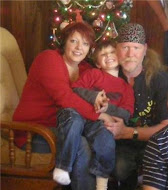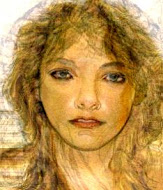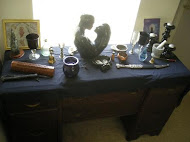This is an excerpt from The Element Encyclopedia of Witchcraft
At its most bare-bones definition, the pre-Gardnerian definition of a witches' sabbat indicated a mass convergence of witches. When considering the "witches' sabbat" it is almost impossible to determine what's real and what stems from the witch-hunters' fears, prejudices, and fantasies. Virtually the only surviving descriptions and information regarding European witchcraft and post-Christian pagan practices derives from witch-hunters' records. To put this in modern context, it is as if knowledge of achievements by those of Africa-derived ancestry was dependent on records written by the Aryan Nation, Ku Klux Klan or similar white supremacist organizations. It is as if thousands of years of Jewish history were written by Nazis. And yet, regarding European witchcraft that is what there is. Nothing can be taken entirely at face value. One must constantly analyze, weigh the motivation and read between the lines.
Did magicians and devotees of ancient spiritual traditions gather secretly in remote areas such as caves, forests, mountain tops or swamps? If they did, wouldn't they do so on magically charged nights like the equinoxes or solstices or those periods when the veil dividing the realms is at its most permeable?
The very name 'sabbat' is an invention of the Inquisition, Nothing indicates that witches ever used that word until it was introduced by the Inquisition. It is not a coincidence that "sabbat" sounds amazingly similar to the Jewish "sabbath." They are frequently spelled identically. with the final "h" or without. (English spelling wasn't formalized until quite late.) The spelling "sabbat" is used exclusively here, as it is in modern Wicca, to avoid confusion and demonstrate that only witchcraft is being discussed.
Attempts were made by the Church to associate witchcraft and sorcery with Jews or vice-versa; defiant. disobedient people who refused to accept Christianity were initially all lumped together. Before witches had "sabbats" the Church claimed they had "synagogues." This was not intended as a compliment or as acknowledgement of witchcraft as religion. During the Middle Ages, official Christianity considered the beliefs and rites of Jews to be the absolute height of perversion. (After Jews were banished from many religions, the spotlight would be turned on witches.) To call something a "synagogue" or "sabbat" was intended as a vile insult.
In the Middle Ages, Church authorities used the term "synagogue" to describe any gathering of heretics; it was widely used by judges and inquisitors until the late sixteenth century. Sabbat, used as a synonym, became exclusively identified with conventions of witches.
Sabbat was but the most popular of the many names for conventions of witches. Scholarly synonyms included sagarum synagoga and strigiarum conventus. Popular synonyms included
- Akelarre: a Basque term deriving from akerra or "billy goat"
- Hexentanz: German for "witches' ball"
- Striaz, striazzo and stregozzo; Italian terms for meetings of witches
According to witch-hunt trial records, the general format of witches' sabbats is as follows:
- Male and female witches gather en masse at night, usually in remote or solitary places
- Although sometimes the staging arena is a local cave or forest, in many cases, particularly for major, very well-attended sabbats, the location was distant and remote. Participants couldn't realistically get there and back in the time allotted, usually overnight. Thus witches were said to "fly" to sabbats using different methods including ointments, transformation, vehicles like broomsticks, on animals or on hag-ridden victims.
- The witch-hunters' sabbat is presided over by a male devil or demon. First-timers must renounce the Christian faith and offer homage to the devil, who appears in various forms, human or animal.
- Then there's a big party; dancing, feasting. orgies. Before leaving, the witches receive a gift (sort of like a goody-bag) of evil ointments, especially ointments enabling them to return or to commit maleficarum (evil witchcraft.)
Negative stereotypes feature prominently in descriptions of sabbats including indiscriminate, incestuous orgies, killing of babies, and ritual cannibalism, especially of babies. (Abortion wars may be at play here; images that depict women bringing baskets of dead babies to lay at the devil's feet could serve as modern anti-choice propaganda.)
Divinity is worshipped in the form of an animal; devotees copulate with the devil, often in the form of an animal. most frequently a goat, donkey, black cat or dog. They pay him homage in grotesque, obscene, sexually charged fashion.
When did the sabbats allegedly take place?
The answer depends upon which trial transcript one depends upon. There are many variations.
Sabbats were held weekly; for the local coven or community. Fourteenth-century depositions form Toulouse emphasize that sabbats were held on Friday evenings, similar to Jewish devotionals. The Basque akelarre was usually held on Friday evenings, as allegedly were Italian witches' sabbats. Why? All kinds of possibilities exist:
- because of attempts to defame witches by associating them with Jews?
- because of attempts to defame Jews by associating them with witches?
- because Friday belongs to the Goddess of Love?
- because Christ was crucified on a Friday and so this was the ultimate disrespect?
There were also seasonal, ceremonial sabbats, three or four times a year, the equivalent of High Holy Days, when witches journeyed form far and wide. Meetings at the Brocken on Walpurgis or Midsummer's may be understood in this context.
Witches' sabbats were always nocturnal and always ended at daybreak. The rooster crows and witches disperse. Before there were notions of Dracula and blood-sucking bats, the word "vampire" was used in the Balkans to refer to witches. The legend that vampires must hide from sunlight and that their power is broken at dawn may derive from this concept.
Where do witch-hunters say witches convene? At crossroads, cemeteries, and ruins (and what ruins were these? Frequently old pagan sites; ruins were often all that was left of previously sacred places); in the woods, in a cave, sometimes at the foot of the gallows, in the churchyard (which typically serves as graveyard, hallowed ground for the faithful), sometimes even inside the Church. Huge, major sabbats were held in far-away remote areas, typically high mountain peaks like Bald Mountain, the Blokula or The Brocken. Many of these places are genuine Pagan sites or areas that witches would value as magically charged. (And not everyone understands the cemetery to be a threatening place. Those who venerate their ancestors will find comfort there.) Nothing indicates that witches didn't meet at night.
Upon what, if anything did the witch-hunters base their distorted notions of the sabbat? Survival of the Bacchanalia? Survival of other Pagan rites? Resentment that other people were indulging in parties? Quite possibly.
How did the witches know when to attend the sabbats? According to witch-hunt era legend, witches and sorcerers have a small mark (sometimes described as "blue") somewhere on their bodies, which tingles or throbs at Satan's summons, (This image was invoked in Harry Potter and the Goblet of Fire in the death-eater's mark.)
If all the superimposed demonology is stripped away, what did witches actually do at sabbats?
They feasted. What did they eat at those sabbat feasts? According to trial transcripts, menus varied depending upon location; however, allegedly the foll0wing was served:
- in Alsace; fricassee of bats
- in England; roast beef and beer
- in Germany: sliced turnips, allegedly as a parody of the host
- in Lancashire: mutton, best if stolen
- in Savoy; roasted children
- in Spain: exhumed corpses, preferably close relatives
Regardless of what they ate, prisoners generally told their inquisitors that the food was cold and tasteless, presumably so that they wouldn't feel bad about not being invited to the party. A point is typically made that salt was omitted, as it is when offerings are made to djinn or fairies.
Attendees sang special songs, known as "Litanies of the Sabbat." During the late Middle Ages, witches allegedly sang lists of angels, cherubim, seraphim, spirits, demons, and so forth requesting compassion, generosity, and mercy. It is fascinating to compare these songs to the contemporaneous sorcerer's practice of commanding and compelling spirits. A similar type of litany may be heard in the New Orleans musician Dr. John's recording "Litanie des Saints," which he describes in the CD liner notes as a mixture of Gris-Gris, Voodoo, Catholic, and African religions. These medieval witches' litanies may also be understood as the practice of simply listing names of spirits, a practice which survives among modern goddess-devotees as a way of honoring spirits and keeping them alive. Sometimes the only surviving aspect of a spirit or deity is an unforgotten name.
According to witch-hunters' fantasies, it's not enough for the witches to eat, drink, and be merry at sabbats. That's not bad enough. They must also mock and desecrate Christian rites.
One can actually observe this process during witch-trial transcripts. The witches initially discuss fairies or their equivalent. The witch-hunters aren't interested. They're theologians, sometimes men of science. Old wives' tales don't hold their attention, any more than they would a modern scientist. They have bigger theological fist to fry: they desire heresy. Under pressure and torture, the fairies eventually evolve into demons.
This is clearly seen in Isobel Gowdie's testimony. Isobel Gowdie is famed as the Scottish woman who, for whatever reason, voluntarily confessed to witchcraft. She initially describes fairies. Her inquisitors were bored and dissatisfied with this, Her Fairy Queen soon emerges as a male devil.
According to early modern Hungarian witchcraft-trial transcripts, somewhat less influenced by demonology than many other regions, the sabbat might better be described as a witches' party or ball, a gathering characterized by fun and merriment, attended by witches, their spirit doubles and/or spellbound victims. (Hungarian witch trial liberally feature accusations of kidnapping by witches. Witches transport the victims to sabbats and other locations.)
Hungarian and Italian women who were accused of journeying to sabbats described beautiful fairy-like sabbats, full of music, dance, and sensuality. Wonderful food and drink is served, better than daily reality. Their sabbats are pleasure dreams, not nightmares. Going to the sabbat was akin to a trip to fairyland, reminiscent of the fairy tale "The Twelve Dancing Princesses," where the girls slip out at night to revel so hard in magical underground grottoes that their shoes wear out.
Sabbats of Modern Wicca
Witch-hunters' descriptions of sabbats have no relevance to modern practice. In Wiccan parlance, Sabbat is the term for eight seasonal festivals, marking the Wheel of the Year based on the ancient Celtic calendar.
The four great fire festivals include Imbolc, Beltane, Lughnasa, and Samhain. Samhain marks the beginning of the dark half of the year, the descent into winter. Beltane marks the beginning of the light half. These are the two portals of the year, birth and death. (Interestingly ancient Babylonian astrology also contains portals of birth and death, corresponding respectively to the Summer Solstice and the Winter Solstice, which correspond to the witchcraft celebrations of Midsummer and Yule.) Imbolc marks the quickening, the first approach of spring, Lughnasa marks the sacrifice of the harvest, the preparation for winter.
Mabon, Yule, Ostara, and Litha are frequently described as the lesser sabbats, although some traditions consider all of equal importance.
*****For further information on this subject and all things witchy, you should consider investing in this book - one of my "go to" books that gets "gone to" quite frequently!
Disclaimer: No one involved in this blog or its contents may be held responsible for any adverse reactions arising from following any of the instructions/recipes on this list. It is the reader's personal responsibility to exercise all precautions and use his or her own discretion if following any instructions or advice from this blog.















No comments:
Post a Comment